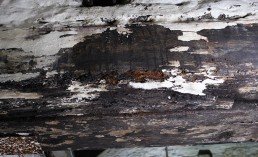What Is Dry Rot?
If you ask most people what rot is, chances are they’ll conjure up a vision of wood left exposed to damp. So if it’s not old window frames trying, and increasingly failing, to fend off the elements, then it’s beams exposed to a leaky roof, or flooring and plasterwork lying prone near dodgy pipework.
Rot is caused by damp, so it follows that rot is wet – ergo there’s a thing called wet rot. But there’s also dry rot as well.
What’s the difference? Both have the same root cause: fungi, which breed and attack wood that’s exposed to damp. Timber with 20 percent moisture content or higher is most prone.
Wet rot is the more common type but is less serious and usually confined to timber that stays…wet. Door and window frames commonly fall prey. Both wet and dry rot starts in the same way: when fungi produce millions of microscopic spores into the air. If they fall on untreated damp wood they will germinate, via tubes known as hypha. These then spread to form a mass of threads called mycelium. The mycelium eats into the wood, spreading through it using the hyphal threads which supply water and nutrients.
The difference between wet and dry rot centres on the type of fungi that infects the wood. There are several common types, but the one that causes dry rot is known as Serpula lacrymans.
And make no mistake: this is, as far as a property’s structural integrity is concerned, the enemy. It can destroy wood and, if left unchecked, can wreak havoc. Moreover, unlike other fungi, it can spread from infected timber onto the surface of nearby stone or brick walls. The hyphal threads penetrate mortar and plaster, meaning that large areas of the wall can become infected. The problem is compounded, well and truly.
How to spot dry rot? Its appearance might be given away by the affected timber appearing darker and also cracking. Wet rots, by contrast, tend to produce a bleaching effect.
Knowing how to tell dry and wet rot apart is hugely important, because each requires a different form of treatment. This is precisely where you need an experienced, professional service, such as that offered by Danford Brewer & Ives.
A detailed inspection should be carried out by a specialist, who will then submit a report detailing both the cause of the rot and the proposed action.
As a rule of thumb, the following areas will be investigated:
• The roof: are there blocked gutters, for example, or missing/broken/displaced tiles/slates?
• The walls: has the mortar/plaster deteriorated; is there faulty/missing damp proof course, blocked air bricks, cracked or broken pipes, or perhaps an overflow from the cistern/water tank?
• Internally: is there excessive condensation in, say, the bathroom and kitchen; moisture close to external faults, solid floors, trapped flood water, or defective plumbing?
Keeping on top of rot can prove difficult; even being aware of it is not easy. That said, a little time and effort in this regard can go an awfully long way.
Fortunately, though, strides are always being made in terms of greater understanding, improved solutions and best practice, meaning that not only is help readily at hand, but that it draws from a greater depth of knowledge. The upshot, therefore, is a better chance to combat and resolve the problem.
Danford Brewer & Ives have a team of experts who can produce reports and quotations for any necessary specialist dry rot work. Moreover, we keep abreast of all the latest innovations, methods and technologies.
If you would like more information on and detail about dry rot - or any of the other building services we offer, such as timber treatment, basement conversions, extensions or building maintenance – then please contact us. As always, we’re more than happy to help.

